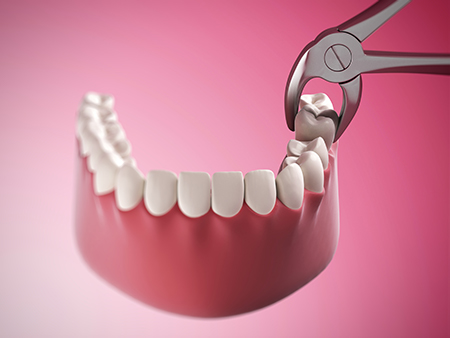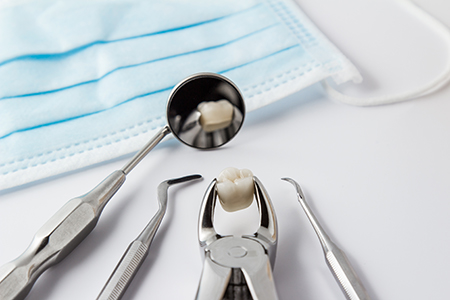

At Silk Dental Delray Beach (formerly Marc Bilodeau DMD), our priority is preserving your long-term oral health. While we always seek to save natural teeth whenever possible, there are times when extraction becomes the safest and most predictable path forward. Removing a problematic tooth can prevent infection from spreading, protect neighboring teeth, and restore comfort and function to your mouth.
Several common situations lead to extraction. A primary (baby) tooth that remains stuck and blocks the eruption of the permanent tooth can interfere with proper development. A permanent tooth that has suffered extensive decay or a severe fracture may no longer be restorable. Advanced periodontal disease that has eroded the bone and soft-tissue support can leave teeth unstable and prone to failure.
Third molars — commonly called wisdom teeth — often lack the space needed to erupt normally and can become impacted, decayed, or harmful to adjacent teeth. Finally, extraction is sometimes part of a broader orthodontic plan when removing select teeth helps create the room necessary to align the smile properly. Each recommendation we make is based on a careful evaluation of the individual patient and the long-term prognosis for the tooth.
Primary teeth that won’t fall out
On occasion a baby tooth does not loosen as expected. When roots fail to resorb or the tooth fuses to the jawbone, it can block its permanent successor. Extracting an over-retained primary tooth can allow normal eruption and prevent crowding or alignment problems as your child grows.
Permanent teeth too damaged to restore
If decay or injury has destroyed the bulk of a tooth’s structure and the remaining tissue cannot reliably support a filling or crown, removal may be the most predictable option. Extracting a severely compromised tooth reduces the risk of chronic infection and removes a recurring source of pain.
Teeth with irreparable fractures
Cracks and breaks come in many forms. Some are minor and easily treated; others split a tooth in ways that compromise both the crown and root. When restorative solutions aren’t viable, extraction prevents further complications and lets us plan for an appropriate replacement.
Advanced gum disease affecting support
Periodontal disease undermines the tissues and bone that anchor teeth. When disease progresses despite treatment, teeth may loosen and become a source of recurring inflammation. Removing a hopeless tooth can help contain disease progression and improve the health of surrounding teeth and gums.
Problematic wisdom teeth
Third molars often present at awkward angles, become partially erupted and infected, or damage neighboring teeth. In those cases, timely removal helps prevent chronic discomfort, cysts, and damage to adjacent structures. We assess each third-molar case individually to determine the best timing for intervention.
Creating space for orthodontic treatment
When the jaws are too small to accommodate all permanent teeth, selective extractions can allow teeth to move into healthier, more stable positions as part of a coordinated orthodontic plan. Such extractions are planned collaboratively with your orthodontist to achieve optimal alignment and bite function.

Before any extraction, we review your full medical and dental history to identify factors that could affect care. Please tell us about current medications, bleeding disorders, heart conditions, joint replacements, or anything else your physician has noted. Certain health conditions may require coordination with your medical team or adjustments to your medications before the procedure.
We use targeted digital imaging when needed to see the tooth and surrounding structures clearly. Those images help us determine whether a straightforward approach will work or if a more complex surgical technique will be required. We will explain what the images show and how they influence the treatment plan so you can make an informed decision.
Your comfort is important to us. Local anesthesia is standard for most extractions, and we will discuss additional anxiety-reduction options if you prefer. For patients with dental fear or for more invasive cases, we can review sedation choices and preoperative instructions to make the experience as calm and manageable as possible.
Extractions are commonly classified as "simple" or "surgical" based on how the tooth is positioned and how accessible it is. Regardless of the type, the goal is the same: remove the tooth safely while minimizing trauma to surrounding tissues. Your dentist will walk you through each step and confirm that you understand the plan before we begin.
When a tooth is fully visible and its root anatomy is routine, a simple extraction is usually performed. After numbing the area, the dentist gently loosens the tooth with specialized elevators and removes it with forceps. The process is quick and controlled; most patients report minimal intraoperative discomfort because of effective local anesthesia.
We offer guidance on what to expect immediately after the extraction, including short-term bleeding and swelling, and we provide clear instructions for managing pain and protecting the clot that forms in the socket. If you have concerns about anxiety or pain control, we’ll discuss additional measures before treatment begins.
Surgical extractions are used for teeth that are broken at the gumline, fused to bone, or impacted beneath the surface. This approach may involve making a small incision in the gum and, in some cases, removing a bit of bone to access the tooth. These procedures are performed with careful attention to precision and comfort and may involve sutures to promote predictable healing.
In more complex situations, we may recommend referral to an oral and maxillofacial surgeon who specializes in surgical extractions. When referral is advised, we coordinate care and communicate closely with the specialist so your treatment is seamless and well-managed from start to finish.

Thoughtful aftercare reduces complications and speeds recovery. We provide individualized post-operative instructions for each patient, but there are common practices that usually apply. These focus on controlling bleeding, managing discomfort, limiting swelling, and protecting the blood clot that forms inside the tooth socket—an essential part of the healing process.
If sutures were placed or your extraction was complex, we will schedule a follow-up appointment to monitor healing and remove stitches if necessary. In certain cases, your physician may also be involved in post-operative care, particularly when systemic health issues could influence recovery. Always follow any tailored instructions we give you.
Control bleeding with firm pressure
We will place gauze over the site to help a clot form. Bite gently but firmly on the gauze for the time recommended. Replace the gauze only as directed, and if bleeding persists beyond what we describe as normal, contact our office for guidance.
Protect numb tissues
While local anesthesia is active, avoid chewing and be careful not to bite your cheek, lip, or tongue. Numbness can last several hours; take precautions until sensation returns fully.
Take medications as directed
If antibiotics or pain medications are prescribed, use them exactly as instructed. For most routine cases, over-the-counter analgesics can manage discomfort, but take any prescribed medications only as recommended by your provider.
Avoid disturbing the clot
Do not rinse forcefully, spit, use a straw, or smoke for the first several days. These actions can dislodge the clot and increase the risk of dry socket, which lengthens recovery and causes additional discomfort.
Manage swelling
Apply an ice pack intermittently on the face for short intervals during the first 24 hours to reduce swelling. Keep your head elevated when resting to help control inflammation.
Avoid tobacco
Tobacco use delays healing and increases the chance of complications. Refrain from smoking or using other tobacco products for at least one week after your extraction.
Choose gentle foods
Stick to soft, cool or lukewarm foods and drinks for the first day or two. Avoid hard, crunchy, or spicy items that could irritate the extraction site. Stay hydrated and progress to a normal diet as comfort allows.
Keep your mouth clean
Maintain oral hygiene by brushing gently and avoiding the extraction area initially. After 24–48 hours, a mild saline rinse can help keep the site clean—use only gentle motions to avoid disturbing tissue.
Attend follow-up visits
If we schedule a follow-up to check healing or remove sutures, please keep that appointment. Monitoring the site ensures you are healing properly and allows timely management of any issues.
If you notice increasing pain, persistent or heavy bleeding, swelling that worsens after 48–72 hours, a bad taste in your mouth, or any other unusual symptoms, contact our office promptly so we can advise you and arrange care if needed.

Removing a tooth sometimes creates an opportunity to restore the smile in a way that improves comfort and function. Replacement options range from removable solutions to fixed restorations and implant-based approaches. Each choice has advantages and considerations, and we will review how they fit with your oral health goals and lifestyle.
Removable dentures can replace one or several teeth and are a non-invasive option for many patients. Fixed bridges anchor to adjacent teeth to fill a gap without needing an implant, while dental implants provide a long-term method to replace a single tooth or multiple teeth with a restoration that closely mimics natural tooth function and appearance.
Our team can walk you through the clinical factors that affect each option — including bone levels, adjacent tooth health, and overall treatment goals — and help you understand the timeline and care involved. We will outline next steps and coordinate any restorative work so your bite, speech, and smile are restored predictably and comfortably.
In summary, tooth extraction is a common, well-understood dental procedure that, when recommended, aims to protect your oral health and improve comfort. Our approach blends clinical expertise with thoughtful planning and clear communication to ensure each patient feels informed and supported. Contact us for more information or to discuss whether extraction is the right choice for your situation.
The most common reasons for tooth loss include advanced periodontal disease, extensive tooth decay, and facial trauma. According to statistics, gum disease is responsible for close to 70% of tooth loss in adults. Although less frequent than the preceding three reasons, it should also be noted that specific diseases, drugs, smoking, and poor nutrition contribute to the risk of tooth loss.
The Centers for Disease Control and Prevention report that in the United States, an average of 12 teeth (including the wisdom teeth) are lost by the age of 50. Also, 26% of adults between 65 and 74 years of age have lost all their teeth.
Every patient and every situation is different. However, when a tooth and the surrounding tissues are numbed with a local anesthetic, you should only expect to feel a bit of pressure, but no pain as the tooth is being loosened from the surrounding tissues and extracted. For patients who are apprehensive and for some surgical extractions, our office will discuss our options in dental sedation to provide further relaxation and reduce any sense of discomfort.
While it's normal to feel some tenderness and swelling following an extraction, the degree of these sensations can vary. It mostly depends on the complexity of the extraction and the body's response to the procedure. We'll recommend or prescribe the appropriate pain medication to help ensure your comfort and give you specific instructions for maximum effectiveness and safety.
Typically, the recovery period following a simple extraction is shorter than a surgical extraction. However, a patient's overall health, habits, the size and location of the tooth, and other variables can influence recovery and healing. To speed up the recovery and avoid any complications, patients must follow the given at-home instructions diligently. We'll carefully review what to expect following your procedure and go over your post-op instructions.
Smoking interferes with blood clot formation, which is an essential first step in the healing process. Blood clot formation not only provides a protective layer to cover the underlying exposed bone and nerve endings, but it also supports the growth of new tissue. Cigarette smoke also contains chemical toxins that can disrupt the healing process and lead to problems such as continued inflammation, infection, or dry socket.
In a very small percentage of cases, a condition known as dry socket can develop in the aftermath of a dental extraction. This painful condition can arise when the blood clot in the extraction site doesn't form properly or gets dislodged. With dry socket, you may experience throbbing pain and symptoms such as bad breath and an unpleasant taste in your mouth. As skilled providers of care, our office will provide immediate treatment to alleviate your discomfort and promote healing.
The last teeth in your mouth to develop, wisdom teeth often do not have enough room to fully erupt or may be positioned in the wrong direction. These issues can affect your dental health as well as overall wellbeing. While some individuals never develop all their wisdom teeth, and a few have sufficient space for them, there are many people with partially or fully impacted third molars. Our office will monitor the development, position, and health of your wisdom teeth and will advise you if and when extractions are indicated.
After a tooth is removed, bone-grafting material is sometimes placed in the socket to promote healing and encourage new bone development. This procedure is often performed to support the eventual and successful placement of a dental implant.
At the office of Silk Dental Delray Beach (formerly Marc Bilodeau DMD), we strive to make dental care affordable and accessible. Depending on the type or complexity of the extraction and other variables, the cost of the procedure can vary. Based on our diagnostic findings, our office will inform you of the healthiest choices in care, explain the fees, discuss insurance coverage, and explain your payment options.
Many dental plans offer some level of coverage for tooth extractions. We'll advise you if your plan covers the full cost of the procedure and if there is any out-of-pocket expense. Our business office will work with you to maximize your insurance benefits as much as possible while helping you minimize any out-of-pocket expenses.
Quick Links